"The Dead Is Alive!": How William Jackson Marion Was Hanged For Murdering A Man Who Wasn't Even Dead
On March 26, 1887, William Jackson “Jack” Marion was hanged in Nebraska for the "murder" of his friend John Cameron. Four years later, Cameron returned alive and well
Background
In 1871, William Jackson “Jack” Marion, a 21-year-old resident of Gage County, Nebraska, married a woman named Lydia Jane Finley, a choice that would have dire consequences.
Marion and his friend John Cameron worked as freight haulers for the railroad. The two roomed together in Clay County, Kansas, but were often on the road for weeks at a time. In May of 1872, the two men traveled to Wild Cat Creek in Gage County, Nebraska, to visit John and Rachel Warren, Marion’s in-laws, before heading to another job.
According to Marion, the day before they left Kansas, he signed a contract to buy a team of horses from Cameron for $315. He paid $30 down with the agreement that Cameron would keep the horses until they were fully paid for.
Surprisingly, a few days later, Marion returned to the Warren home with Cameron’s horses and belongings … alone. When his wife Lydia asked about Cameron, Marion said he had bought him out because he had to leave in a hurry.
Marion’s mother-in-law, Rachel Warren, expressed suspicion that Marion had killed Cameron. But, with no proof or body, her suspicion remained just that.
Body Found
A year later, in 1873, a half-buried, decomposing body was found in a creek bank on the Otoe Indian Reservation. The reservation lay between southern Gage County, Nebraska, and northern Kansas.
Three bullet holes were discovered in the skull, leading to a suspicion of murder. A coroner’s inquest was held. It didn’t take long for Rachel and Lydia Warren to agree on one thing: the corpse was wearing clothes that they had last seen on John Cameron.
According to the coroner’s presumptuous inquest, “The said John Cameron came to his death on or about the 4th of May 1872 by means of a bullet or bullets shot from a revolver in the hands of Jackson Marion.” (Renschler, 2018)
Newspapers in the town of Beatrice, called Marion, “A hardened and remorseless wretch thus to murder a friend for the paltry value of a team and an old wagon.”
Manhunt
Nathaniel Herron had been elected sheriff (and fire chief) of Gage County. Once the coroner’s inquest presumed Marion’s guilt, Herron took it upon himself to search for the ‘murderer.’ It became almost an obsession.
Sheriff Herron had a hunch that Marion killed Cameron, and he wouldn’t stop until he had located him. Ten years later, he finally got his wish. In January 1883, Marion was arrested for trying to steal a wagon in Sedan, Kansas. Sheriff Herron brought Marion back to Gage County to stand trial for his previous crime.
The Gage County Democrat would commend the sheriff’s diligence to the law and his “persistent manner in which he hunted down criminals generally and this one in particular.”
With the ten-year “manhunt” over, Marion was taken to Beatrice, Nebraska, to stand trial.
Trial
For the next four years, Marion would be a guest of the Beatrice Jail. His trial became a sensation, being the first capital murder case in the short history of Gage County. Before Marion’s trial, Nebraska had only had a few other murder trials and only one execution.
Due to the high demand for viewing, the trial was relocated to the Opera House to accommodate a larger audience. Throughout the trial, Marion proclaimed his innocence. When he and Cameron parted company, his friend had been alive.
Cameron had sold him the horses because he had to leave in a hurry. Marion had signed a bill of sale.
Most of the evidence in the two-month-long trial was circumstantial. The decomposing corpse was brought into the courtroom, ten years after the fact, to “prove” the victim’s identity. His rotting clothing was “positively” identified by both Marion’s wife and her mother as the clothes they’d seen Cameron wearing.
The most damming witness turned out to be Rachel Warren, Marion’s mother-in-law. Vindictively, she insisted that she knew Marion had murdered Cameron. She claimed she had packed Cameron’s trunk the night before the men left for Kansas.
According to Warren, she knew exactly what clothes were missing. Even the newspapers remarked about her “hatred” for her son-in-law.
When he took the stand, Marion maintained his innocence. His defense attorney and Uncle, William Wymore, tried his best, but did a poor job representing his nephew. After several minutes of deliberation, the jury returned a verdict – Guilty of Murder in the First Degree.
The judge sentenced him to die. A leather-bound book of court reporting recorded the sentence: “He shall be taken by the sheriff to the place of execution and be hanged by the neck until dead, dead, dead.” Marion was doomed.
Second Trial and Execution
Despite the verdict, Marion was given a second chance at justice. The Nebraska Supreme Court delayed his execution, stating that only a jury could sentence a man to death, not the judge.
A second trial followed, lasting only one week. Once again, the verdict came back guilty. This time, the jury sentenced him to hang.
Through it all, Marion continued to claim his innocence. Jailers would later report that he was a quiet, gentle prisoner. His only request before his death was to be taken to the gallows and shown how it would “work.” The request was granted.
On March 26, 1887, Marion was led to the gallows. He used his last words to proclaim his innocence one final time. He was then hanged for the murder of John Cameron, and his body was taken to an unmarked grave and buried in the Potter’s Field of the Beatrice Cemetery.
Return of John Cameron
After Marion’s execution, his uncle, William Wymore, who had unsuccessfully defended him, still felt convinced of his nephew’s innocence. In fact, Wymore believed that Cameron was still alive. He made it his life’s mission to track down the man and prove to the world that Marion had been telling the truth.
It turns out that Wymore would have made a better detective than lawyer, because although it took him four years, Wymore eventually located John Cameron alive and well in La Crosse, Kansas.
Cameron admitted that in 1872, he had fled to Mexico to avoid a woman who claimed he’d fathered her child. From there, his travels led him to Alaska, Colorado, and back to Kansas. Sadly, he had heard nothing of Marion being on trial or executed until after the fact.
Cameron could still produce the bill of sale Marion had given to him for the horses. The headline in the Beatrice Daily Mail blared out the truth, “The Dead is Alive!” Marion’s vindication shook the Nebraska legal community. After two trials and a review by the highest court in the state, they’d still executed a man for a crime he didn’t commit.
Pardon
Despite this, it still took one hundred years for William Jackson Marion to receive the pardon he deserved. His grandson, Elbert Marion, worked tirelessly to have Marion posthumously pardoned.
In March 1987, one hundred years after his death, Governor Robert Kerry pardoned William Jackson Marion.
In February 2013, a documentary entitled “…until he is dead. A history of Nebraska’s death penalty,” explored the hanging and pardon of William Jackson Marion.
Sources:
William Jackson Marion - Alchetron, The Free Social Encyclopedia. (2024, October 2). Alchetron.com. https://alchetron.com/William-Jackson-Marion
William Jackson Marion - National Registry of Exonerations pre 1989. (n.d.). https://www.law.umich.edu/special/exoneration/Pages/casedetailpre1989.aspx?caseid=212
1887 hanging remains Nebraska’s most controversial execution. (n.d.). Nebraska Public Media. https://nebraskapublicmedia.org/en/news/news-articles/1887-hanging-remains-nebraskas-most-controversial-execution/
1887: William Jackson Marion, who’d be pardoned 100 years later | Executed Today Headsman. (2011, March 25). 1887: William Jackson Marion, who’d be pardoned 100 years later | Executed Today. https://www.executedtoday.com/2011/03/25/1887-william-jackson-marion-wrongful-execution-pardon/
An Innocent Man Hanged – Catherine’s CornerRenschler, A. C. (2018, August 24). An innocent man hanged – Catherine’s corner. http://catherinescorner.net/?p=638



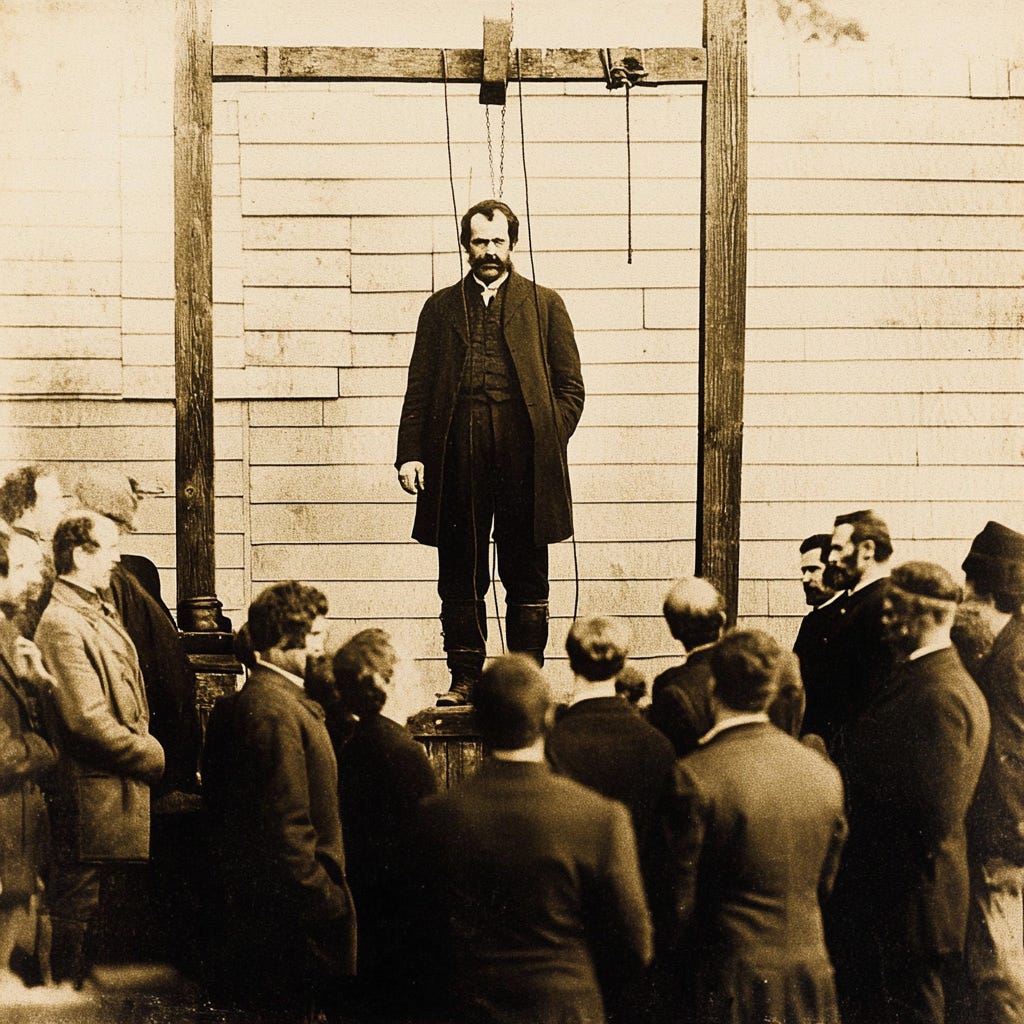
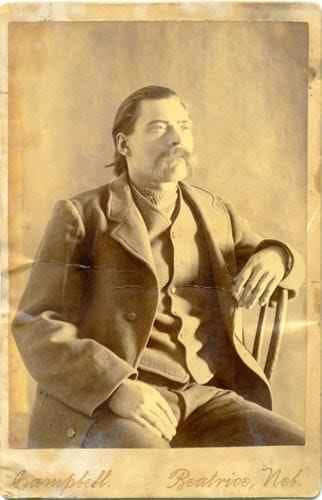
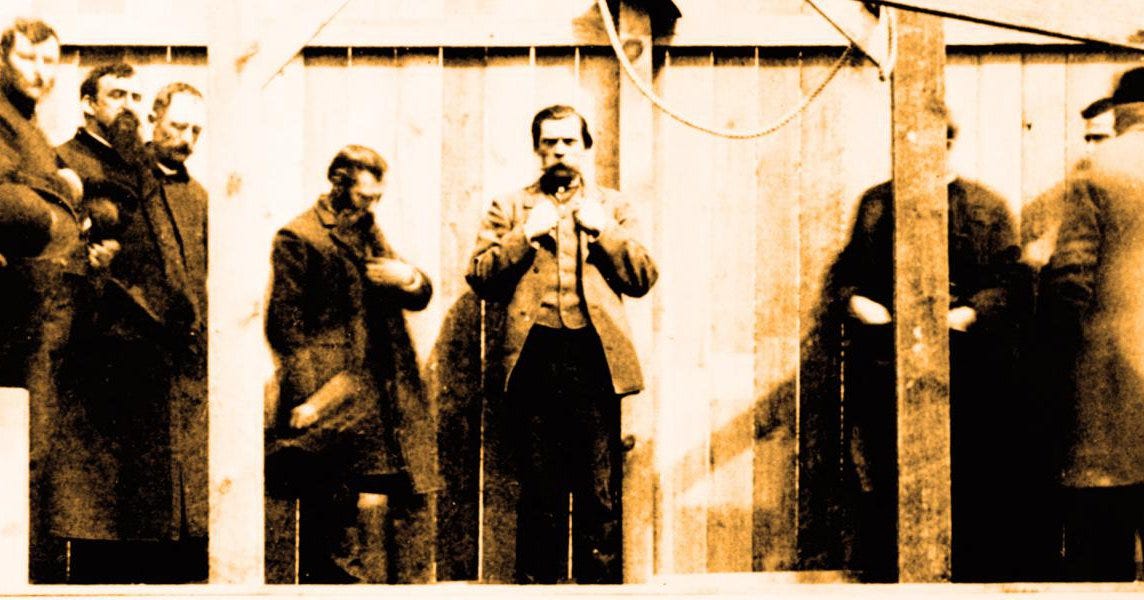
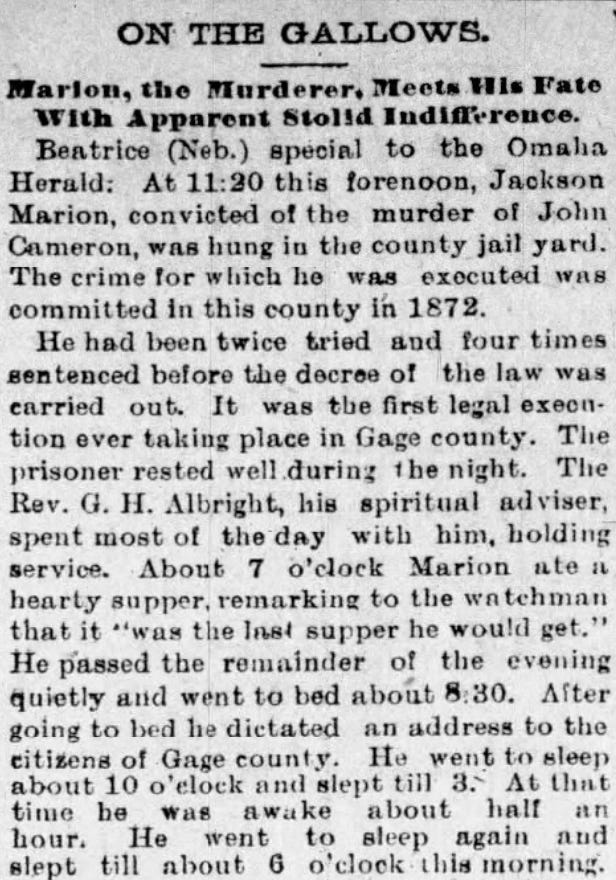
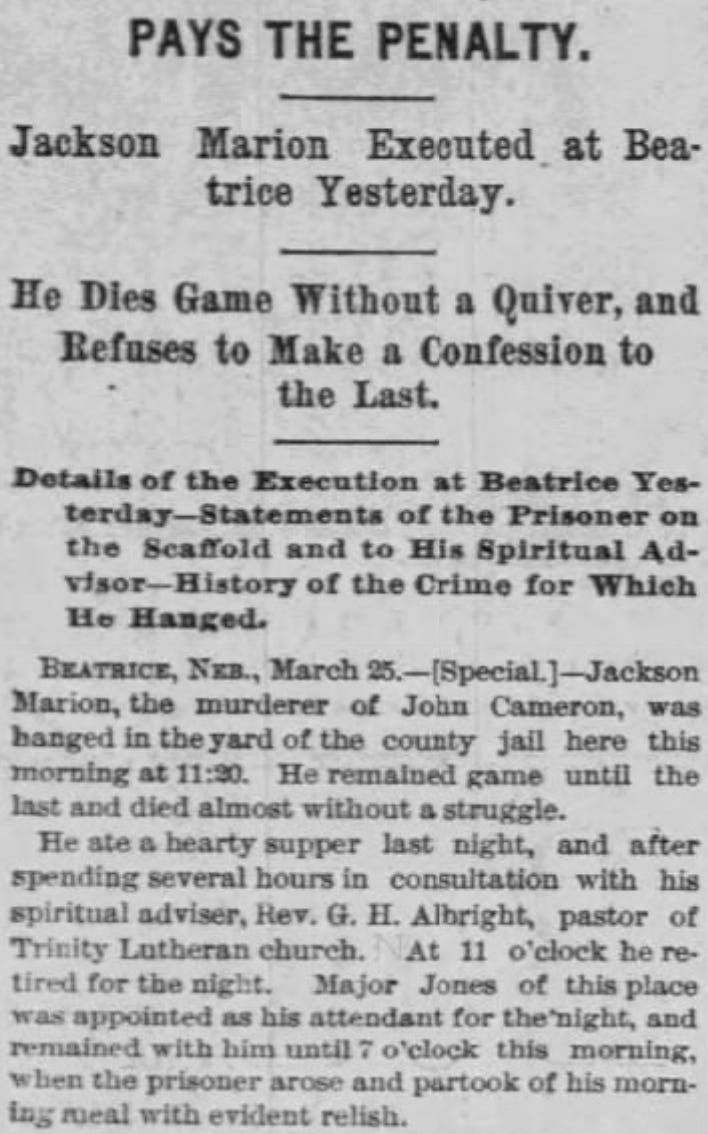
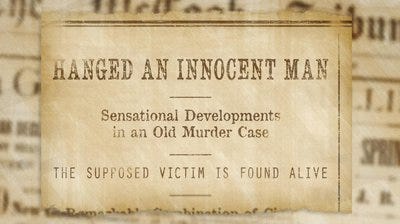
"He shall be taken by the sheriff to the place of execution and be hanged by the neck until dead, dead, dead."
Interesting wording. Did they think he couldn't be hung on the first go-round, and the execution needed three tries to get it right?
Did they ever figure out who the random dead guy was?